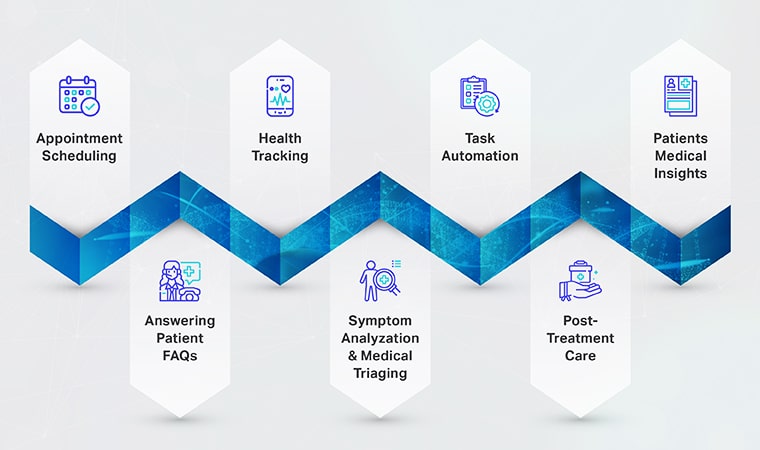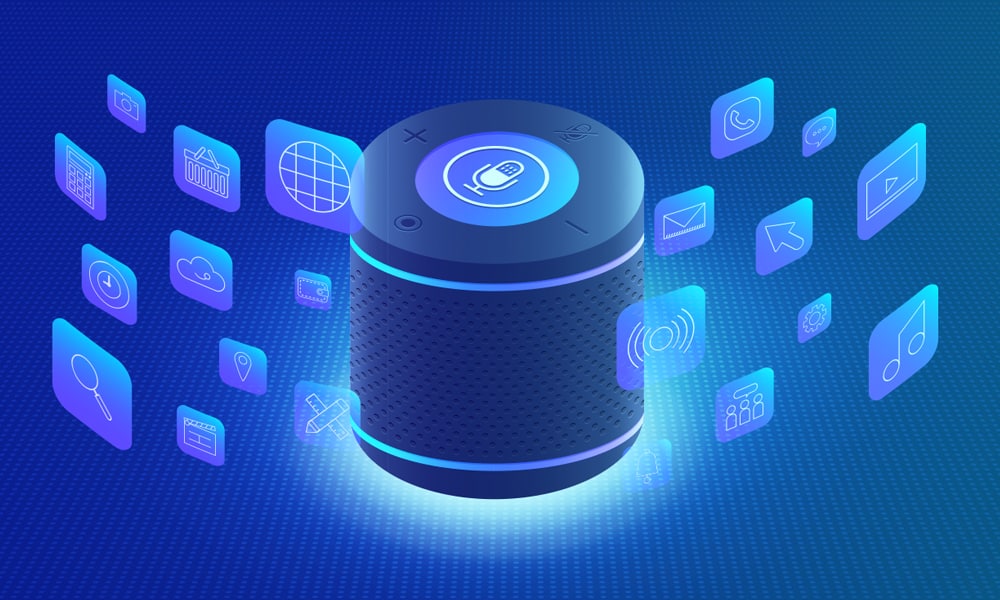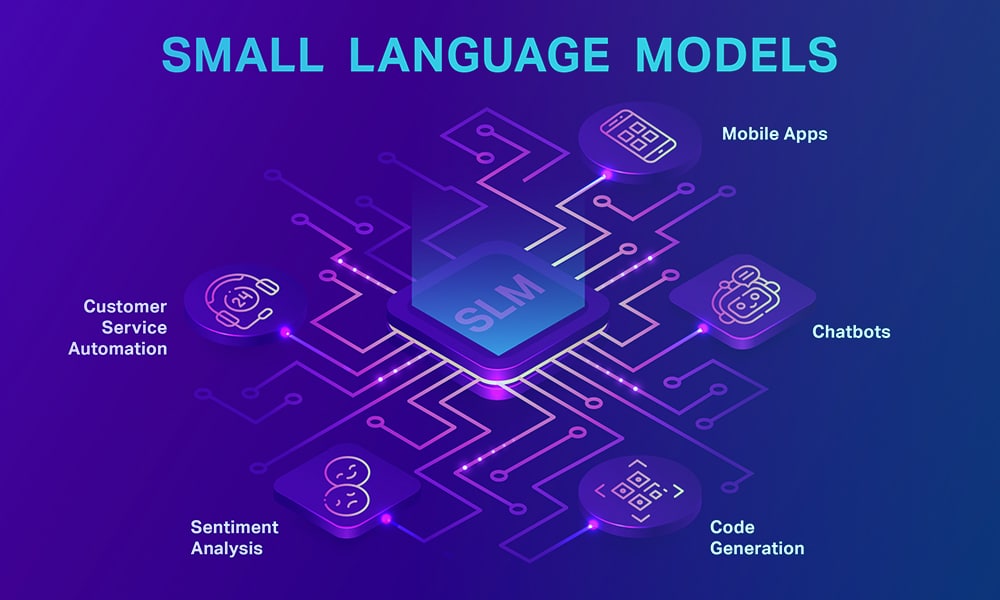AI in healthcare is a relatively new technology but has gained momentum over the past few years. It has been used for various tasks, from diagnosing illnesses to providing personalized treatments to automating administrative tasks. However, with recent improvements in data storage and computing capabilities, more efficient conversational AI solutions have been introduced in healthcare systems.
These Healthcare Conversational AI systems are virtual assistants built to provide personalized healthcare services to patients. By facilitating one-on-one conversations and streamlining various healthcare services, these medical chatbots significantly improve patient engagement with healthcare providers and help patients access better healthcare facilities.
Top Use Cases of Conversational AI in Healthcare
Incorporating AI into healthcare offers many benefits for patients and healthcare workers. Some of the few areas where Healthcare Conversational AI can be used are:

Patient Appointment Scheduling
Scheduling appointments with doctors in several healthcare facilities is a sluggish task requiring a substantial amount of time to wait over the phone. Fortunately, users can seamlessly book appointments with their preferred physicians by leveraging Conversational AI systems. Additionally, the personalized healthcare assistant can assist you with rescheduling and cancellation of appointments.
Regular Health Tracking
Healthcare Conversational AI systems can help patients stay on track to reach their health goals, such as body weight, mood, etc. These medical chatbots provide users with detailed information about the necessary steps to meet their goals regularly. In addition, it consistently follows up with the patient’s progress and helps them stay on track with their routines.
Answering Patient FAQs
Patients often have several questions surrounding their minds for which they seek answers from their doctors. Unfortunately, answering every patient’s doubts and questions is impossible due to doctors’ stringent routines and time constraints. A Conversational AI is the most suitable choice in such a scenario. You may ask any questions from the medical bot, which will provide suitable answers.
Symptom Analyzation & Medical Triaging
Healthcare Conversational AI systems can offer a streamlined diagnosis of patient issues by probing into the symptoms entered by the patient. The system thoroughly analyses all patients’ symptoms and generates viable insights into the issues that may be troubling the patient. Based on the results, the system will either book an appointment with a suitable doctor or help you provide a treatment plan if the issue is minute.
Administrative Tasks Automation
Most healthcare facilities are generally buried under the overload of administrative tasks on a daily routine. The automated systems can simplify the process by allowing healthcare workers to submit requests, send updates, and track the status of the requests. Conversely, the bots can also help with the onboarding process for the patients and help cater to their problems more effectively.
Post-Treatment Care
An efficient Conversational AI system can generate post-care plans for the patients, depending on their physician’s diagnosis and medical history. These treatment and post-care plans are embedded within the account, and when asked, the medical bot will deliver you the required information.
Vital Medical Insights of the Patients
Healthcare Conversational AI is smart and can detect patterns and trends in patients’ medical data with NLP and ML algorithms. They provide valuable insights into the patient’s data and records, which can be useful for designing post-treatment care for patients and improving patient satisfaction.
The Role of ML in Developing Conversational AI
Machine learning is an important tool in developing Healthcare Conversational AI. ML algorithms analyze vast amounts of data to identify patterns and correlations to improve the accuracy and effectiveness of the conversation. Mainly there are three major aspects of machine learning algorithms.
- Intent: It is the goal or purpose of an AI system. Intent refers to the expression of the user’s desire or the task that the AI system is attempting to complete on behalf of the user. It may comprise questions in structured or unstructured formats.
- Entities: These groups of unique keywords may mean distinct things but belong to the same category. For instance, synonyms, abbreviations, etc.
- Examples: These are distinctive ways in which people can express a similar intent differently. For example, a person may ask the same question in two different ways: ‘Can I change my appointment’ or ‘Is it possible to postpone my appointment’?
Challenges of Implementing Conversational AI in Healthcare
- Data Privacy and Security: Ensuring the privacy and security of patient data is crucial when implementing conversational AI in healthcare. Healthcare organizations must adhere to strict regulations such as HIPAA and GDPR to protect sensitive patient information.
- Integration with Existing Systems: Integrating conversational AI with electronic health records (EHR) and other healthcare systems can be challenging. Ensuring seamless integration is essential for the effective functioning of AI-powered virtual assistants.
- Accuracy and Reliability: Conversational AI systems must provide accurate and reliable information to patients. Inaccurate or misleading information can have serious consequences in the healthcare context. Regular testing and validation of the AI models are necessary to ensure their accuracy and reliability.
Significant Challenges in Healthcare that Conversational AI Can Solve
Like every other industry, healthcare has challenges, now addressed by Healthcare Conversational AI. Let us look at some of them:
Limited Access to Training Data
Limited access to training data is certainly a challenge for developing data-driven models for healthcare services. Machine learning and AI models cannot be trained accurately without elaborate training data. More data is essential in identifying patterns and detecting anomalies, leading to accurate diagnoses, correct treatments, and lowered treatment costs.
Data Privacy and Security for Patients
With the inception of healthcare comes an increased risk of data breaches, malicious attacks, and other security threats. AI solutions must ensure the right data is collected, stored, and used securely. This includes managing access to patient information, ensuring that data is encrypted, and regularly monitoring for security vulnerabilities.
Integration with EHR and Other Healthcare Tools
Another significant challenge to developing Conversational AI in healthcare is integrating AI models with patients’ Electronic Health Records. EHR is the complete medical record of a patient in healthcare facilities that must be linked with conversational AI models to obtain accurate and desired patient outcomes.
Disambiguity in Medical Terminology
Medical terminology is vast and can significantly differ when used by physicians and patients. Hence, a substantial gap between the user’s language and the AI model can be generated, leading to false outcomes. It is a big challenge that is not yet entirely solved and is being worked upon to make medical bots more efficient and accurate.
Compliance with Clinical Protocols
Medical terminology is vast and can significantly differ when used by physicians and patients. Hence, a substantial gap between the user’s language and the AI model can be generated, leading to false outcomes. It is a big challenge that is not yet entirely solved and is being worked upon to make medical bots more efficient and accurate.
Benefits of Conversational AI in Healthcare
- Improved Patient Engagement: Conversational AI enables 24/7 access to healthcare services, allowing patients to get answers to their questions and receive support whenever they need it, leading to higher patient satisfaction and engagement.
- Increased Efficiency: By automating routine tasks such as appointment scheduling, symptom checking, and providing basic health information, conversational AI frees up healthcare professionals to focus on more complex and critical tasks, improving overall efficiency.
- Cost Reduction: Implementing conversational AI can help healthcare organizations reduce costs by minimizing the need for human intervention in repetitive tasks and reducing the workload on healthcare staff.
Conclusion
Healthcare Conversational AI offers patients unprecedented access to personalized care and medical expertise. Conversational AI systems facilitate improved patient medical outcomes by providing more accurate diagnosis and treatment advice. If you also wish to develop a functional Conversational AI for your healthcare organization, contact our Shaip experts today!
[Also Read: The Complete Guide to Conversational AI]








